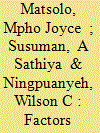| Srl | Item |
| 1 |
ID:
157767


|
|
|
|
|
| Summary/Abstract |
The purpose of this research is to investigate and analyse higher education institutions’ enrolment and drop-out rates within the Gauteng province, South Africa. Large-scale secondary data from the General Household Survey, obtained from Statistics South Africa (2012) were used. This study’s findings show that finance, orphan-hood, transport to the higher education institutions and, to a lesser extent, unplanned pregnancies, are some of the main factors that affect the enrolment rate of students. This study hopes to be useful to policy-makers, research managers and other decision-makers within the higher education (HE) landscape.
|
|
|
|
|
|
|
|
|
|
|
|
|
|
|
|
| 2 |
ID:
153104


|
|
|
|
|
| Summary/Abstract |
This study examines the risk associated with inconsistent use of condoms as a risk factor for human immunodeficiency virus/sexually transmitted infections (HIV/STIs) and sexual risk behaviours. The Malawi Demographic Health Survey 2010 data were used. Out of a sample of 2987 males and 9559 females aged 15–24 years, 511 males and 675 females were filtered in the present study. A Chi square test and logistic regression techniques were performed. About 147(28.7%) males and 240(35.6%) females reported inconsistent condom use. The likelihood of inconsistent condom use was higher among females with secondary/higher education (odds ratio’s (OR)=1.46), with more than one partner (OR=4.27), and married males (OR=8.76), with more than one sex partner (OR=1.78).There is a need to raise condom use awareness and improve sexual education about consistent condom use, especially among females, in order to curb the spread of HIV/STIs and reduce sexual risk behaviours.
|
|
|
|
|
|
|
|
|
|
|
|
|
|
|
|